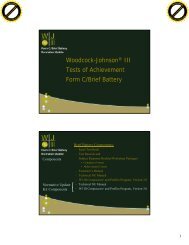[PUBLISH] IN THE UNITED STATES COURT OF APPEALS FOR ...
[PUBLISH] IN THE UNITED STATES COURT OF APPEALS FOR ...
[PUBLISH] IN THE UNITED STATES COURT OF APPEALS FOR ...
Create successful ePaper yourself
Turn your PDF publications into a flip-book with our unique Google optimized e-Paper software.
was able to work but that she thought he did not want to; she pointed to his report<br />
that one of his jobs was easy, that he left one job because he could get paid more at<br />
another, and that he lost still another because of his choice to go “peeping” rather<br />
than going to work.<br />
By contrast, Dr. Salekin found significant deficits in several areas of<br />
adaptive functioning. Her review of the record left her with an impression of<br />
consistency across time that Holladay had significant deficits. First, Dr. Salekin<br />
cited Holladay’s academic record, noting that he was illiterate and had only<br />
completed the sixth grade. Moreover, his school records reported that his<br />
promotion was “social” and that he received “Fs” in all subjects every year except<br />
once when he received a “C-.” To rule out Dr. Ackerson’s theory that Holladay<br />
had a learning disability and statement that he did not have broad-based cognitive<br />
deficits, Dr. Salekin administered the Woodcock-Johnson Tests of Achievement -<br />
3rd edition. This test measures academic achievement and Dr. Salekin could not<br />
administer parts of it to Holladay because of his illiteracy. The test revealed that<br />
Holladay suffered from broad-based deficits, with some strengths in oral language,<br />
oral expression, and listening comprehension; however, even those scores<br />
correlated to lower elementary grades.<br />
Dr. Salekin also identified Holladay’s communication, social, employment,<br />
31


![[PUBLISH] IN THE UNITED STATES COURT OF APPEALS FOR ...](https://img.yumpu.com/22422353/31/500x640/publish-in-the-united-states-court-of-appeals-for-.jpg)













